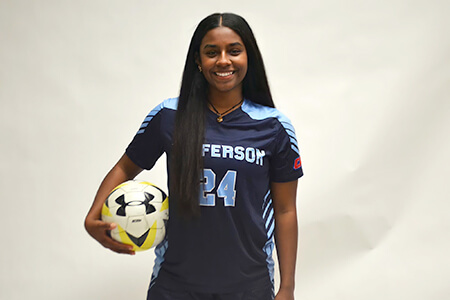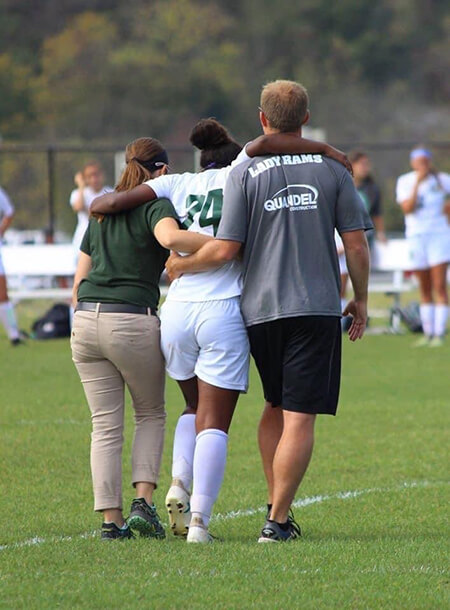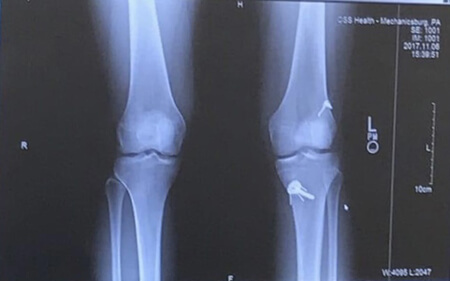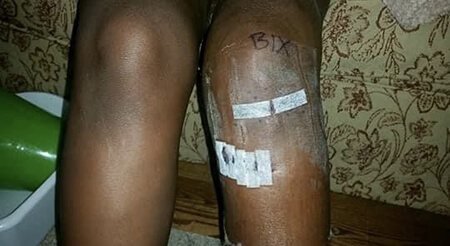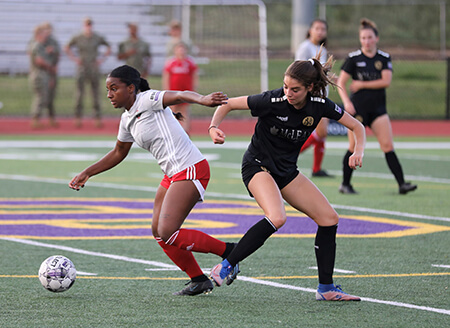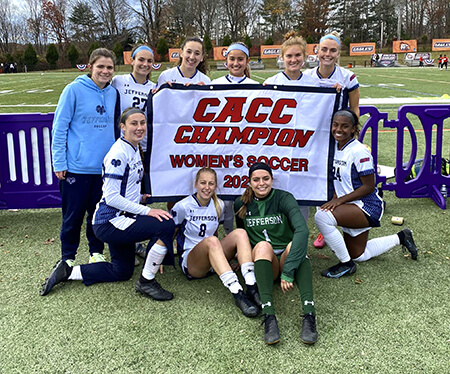Becoming a soccer injury statistic: Jeena’s story
Posted on 8/15/2021
How tearing my ACL made me better on and off the field
As an avid soccer player and athlete, I’m intrigued by sports stats. Like this one:
Each year in the U.S., between 20,000 to 80,000 female athletes sustain an ACL injury. Most of them in playing soccer and basketball.
To me, that’s a scary statistic.
But it was the last thing on my mind as a 15-year-old competitive soccer player in 2017.
Back then, I only cared about getting to play college soccer at the highest level.
I had a plan!
- Get recruited.
- Play soccer at a high level
- Figure out everything else later.
I didn’t care where the school was or what I studied, because I had a plan – my Plan A. My plan told me I didn’t need to worry about anything else. If it was outside of playing soccer, it fell into the category of “figure out everything else later.”
I felt good about my plan.
Nothing could get in the way of me and Plan A.
Right?
CRACK!
That was the sound that came from my knee during a high school game that year.
I got hit while dribbling down the field.
All of a sudden I became one of those statistics. And I was in the worst pain I’ve ever been in.
In an instant, everything changed.
ACL spells agony… and (eventually) accomplishment
I tore my ACL completely.
I needed surgery, to be followed by physical therapy… for nine months.
No soccer for nine months? In my mind, my life had just ended.
I had surgery a few weeks later and wondered if I would be the same player as before my injury.
There’s a reason they say ‘never Google your injury or illness.’ My brain was filled with more statistics and stories of players who never returned and players who experience an ACL re-tear soon after returning to their sport.
After looking online, I wasn’t hopeful.
ACL rehab took the place of soccer. I went two and three times a week.
Without practice, I had extra time on my hands. I filled it with thoughts about how much my life sucked. I was in a dark space mentally and emotionally and didn’t know how to get out of it. A good friend noticed and invited me to go to yearbook club with her. With nothing else to do, I went.
It opened my eyes to the possibility of enjoying something unrelated to sports.
I saw fellow students writing stories and designing pages for the yearbook. I heard the buzz of enthusiasm as they worked as a team. Each person doing their part to create a representation of our school.
Teamwork, huh?
I realized for the first time since I tore my ACL that I wasn’t thinking about it. I wasn’t thinking about soccer, either. I was happy.
I went again the next week.
For months, as I continued to heal from my ACL injury, I was an honorary member of the yearbook team. I was also working hard at physical therapy.
One of my teachers, and yearbook advisor, saw my work and recommended Communications as a possible college major. I put my focus into that.
Without realizing it, I’d found my Plan B:
- Study Communications in college.
- Find a school I liked (location, size and culture).
- Figure out everything else later.
Finally, the nine months were over.
I was released from physical therapy with no restrictions.
But I still had a lot of emotions going on. Many less-than-confident thoughts in my head.
It was time to play soccer again.
I was terrified to step on the field.
Coming back was not easy.
It took me another six months to feel comfortable in the game. I was out of shape, and my knee hurt every day.
I stuck it through and with hard work – just like I did in PT – (and muscle memory), things did start to come back.
While my teammates were getting recruited, I was still trying to fall back in love with soccer. Things had changed a bit. I was comfortable with my Plan B.
I found a school that checked all my Plan B boxes. I set my sights on going there, with or without soccer. Because, in Plan B, soccer now fell into the category of “figure out everything else later.”
Turns out the school also had a pretty good women’s soccer team, and they were doing an identification camp (an opportunity to get recruited).
Jeena working the ball in the United Soccer League game.
I went to camp, but with a different mindset than previous camps.
The old soccer me had gone into camps feeling nauseous and panicked by stress. This time I was pretty chill.
It was one of my best performances at a camp.
Fast forward, now five years later, and I am a rising junior, studying Communications at Thomas Jefferson University. I’ve won two conference championships and made a National Collegiate Athletic Association tournament appearance.
I’m one of three captains, and looking to win my third championship and the team’s fourth consecutive title.
I also completed my first season in the United Soccer League (USLW), a pre-professional women’s soccer league.
I’m currently living out what I now call my Plan A/B:
- Playing soccer at a high level.
- Studying Communications at a school I love.
- Figuring out everything else… later.
Before surgery, I wondered if I’d be the same player after. I don’t have to wonder anymore. I am not the same player I was before I tore my ACL.
I am a better one.
Faster, smarter and better on the ball.
The ACL recovery process is a long and painful one. It can be overwhelming.
But if injury recovery is ever in your path, you have more control than you might think.
I learned things about myself I never would have known if I didn’t take time away from soccer.
My ACL tear gave me more than it took from me because I refused to let that happen.
Our individual experiences will be different, for sure. What I can tell you from my experience, though, is that no one else can do it for you. Your physical therapy will be a critical part of recovery. You’ll be part of a team – working with professional therapists who will be rooting for you.
You don’t have to give up on your Plan A… you might just need to adjust it.
Jeena Pressley completed her 2022 summer intern program with Select Medical in the Communications and Branding Department. She is a student-athlete at Thomas Jefferson University studying Communications. Her return to campus as a junior captain for her soccer team will see her on the field looking to defend her team’s CACC Champion title.


